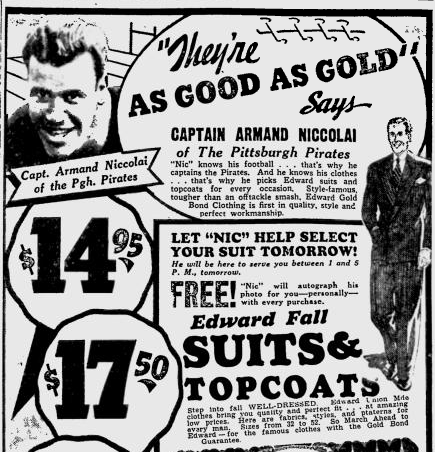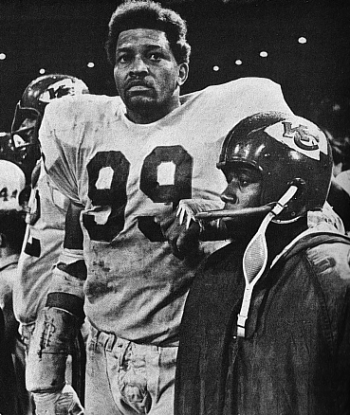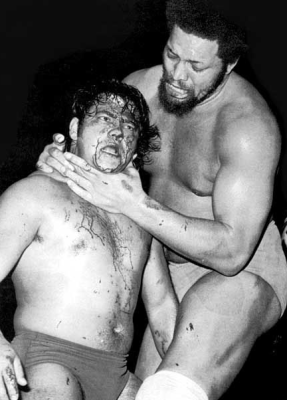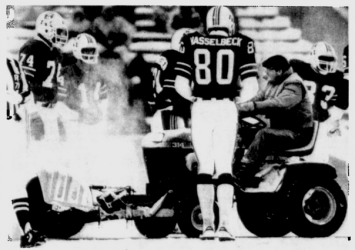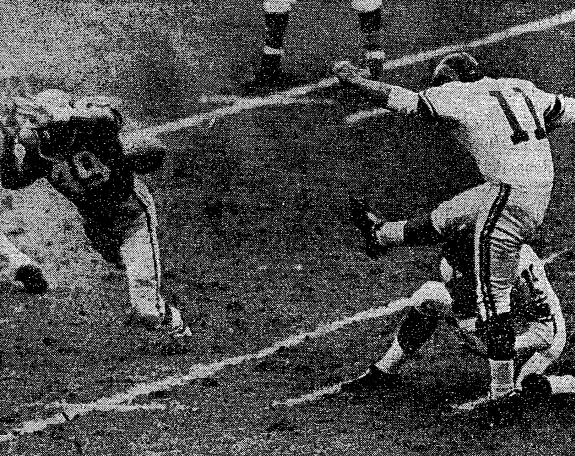A snowflake fell in St. Louis on the first Sunday of the NFL season. Not the shoveling kind; the Dave Kindred kind. “At every game, if you’re paying attention, you’ll see something you’ve never seen before,” the esteemed sportswriter once wrote. “It’s my Snowflake Theory. Every game is somehow different from every other game ever played.”
Often, of course, these snowflakes are barely visible to the naked eye, of little consequence in the course of human events. Sometimes, though — when we get lucky — they’re big, fluffy things, happenings that are discussed, analyzed, marveled at and even laughed about long after the clock hits zeroes.
Which brings us to Cordarrelle Patterson, the Vikings’ multi-purpose wide receiver. Patterson, you may have heard, rushed for 102 yards in the Vikes’ 34-6 win over the Rams. No wide receiver — in the modern era, at least — had ever had a 100-yard rushing game. Before that, the best rushing performance by a wideout was 86 by the Seahawks’ Joey Galloway. (He got them all on one play, a touchdown run against the Jaguars as a rookie in 1995.)
Patterson had a quiet offensive day otherwise, though — three catches for 26 yards — so we’re still waiting for a wideout to rack up 100 yards receiving and 100 yards rushing in the same game. That’s the Holy Grail — like 49ers’ Colin Kaepernick flirting with an unthinkable 300 yards passing/200 yards rushing game against the Packers in the 2012 playoffs. (He settled for 263 and 181, which is ridiculous enough.)
Here’s some Stat Candy for you:
WIDEOUTS WITH 100 YARDS RECEIVING, 50 RUSHING IN A GAME SINCE 1960
| Date |
Player, Team |
Opponent |
Rec |
Rush |
|---|
| 11-12-95 |
Joey Galloway, Seahawks |
Jaguars |
5-114-2 |
1-86-1 |
| 9-20-82 |
James Lofton, Packers |
Giants |
4-101-0 |
1-83-1 |
| 11-5-06 |
Javon Walker, Broncos |
Steelers |
6-134-2 |
1-72-1 |
| 1-16-83 |
James Lofton, Packers |
Cowboys |
5-109-1 |
1-71-1 |
| 10-11-87 |
Kelvin Edwards, Cowboys |
Eagles |
6-100-0 |
1-62-1 |
| 12-5-76 |
Freddie Solomon, Dolphins |
Bills |
5-114-1 |
1-59-1 |
Note: Figures are receptions (or rushing attempts), yards and touchdowns.
Kind of thought Percy Harvin would be in this group. But Harvin’s top rushing total in a 100-yard receiving game is 45 in ’09 vs. the Bears. In fact, he’s rushed for as many as 50 yards just once — on a day he was held to 42 receiving.
Still, Percy strikes me as the kind of player who has a snowflake or two in him. He and Cordarrelle both. This gets me thinking about other snowflakes, other singular single-game events — or, at the very least, exceedingly rare events. The list I came up with:
● Intercepting a pass and scoring a safety. In modern times, the only player who has this double on his resume is James Harrison. Against the Chargers on Nov. 16, 2008, the Steelers linebacker sacked Philip Rivers in the end zone, caused a fumble that was recovered by tackle Marcus McNeill, then tackled McNeill in the end zone for the two points. Later Harrison picked off a pass and ran 33 yards to the Pittsburgh 43. I don’t remember anybody making a big deal of this. And in addition to being highly unusual, it happened in a single quarter (the second). What got more attention — for whatever reason — was that the game produced the first 11-10 final score in NFL history. (Thanks to James’ heroics, Pittsburgh eked it out.)
● 100 rushing yards and 100 punt-return yards. Bears Hall of Famer Gale Sayers did this the same day he tied the NFL record by scoring six touchdowns against the 49ers (Dec. 12, 1965). He was 9 for 113 rushing (long: 50) and 5 for 134 running back punts (long: 85). No one else has managed it since.
● Throwing an interception and intercepting a pass. A Steelers rookie named Tony Dungy chalked up this exploit on Oct. 9, 1977. At safety, the future Bucs and Colts coach picked off a Dan Pastorini throw for the first interception of his pro career. As if that weren’t enough, he also served as Pittsburgh’s emergency quarterback in the fourth quarter — after Terry Bradshaw and Mike Kruczek got hurt — and threw a pair of INTs. (He’d been a QB in college at Minnesota.) Maybe Bill Belichick could let Julian Edelman try this. Edelman, the all-purpose Patriot, has seen action at DB in addition to playing receiver and was a quarterback at Kent State.)
● Three touchdown catches and a punt-return TD: Az-Zahir Hakim, Rams, vs. Bengals, Oct. 3, 1999. TD receptions (all from Kurt Warner): 9, 51 and 18 yards. Punt return: 84. Five players since 1960 have had three (or more) touchdown grabs and also scored a rushing TD — all backs — but only Hakim has accomplished this particular combo. And it’s getting harder to do with all the specialization now.
● 100 punt-return yards with a punt-return TD and 100 kickoff-return yards with a kickoff-return TD. Walter Payton’s younger brother, Eddie, had a game like this for the Vikings against the Lions on Dec. 17, 1977. Kick returns: 5 for 184 with a 98-yard score. Punt returns: 3 for 105 with an 87-yard score.
● 150 yards from scrimmage and 150 yards on punt and kickoff returns. Since 1960, it’s been done as many times in the playoffs (2) as in the regular season. Go figure. The postseason guys:
— Darren Sproles, Chargers, Jan. 3, 2009 vs. Colts: 150 yards from scrimmage (105 rushing, 45 receiving), 178 return yards (72 on punts, 106 on kickoffs). He also scored the winning touchdown in overtime on a 22-yard run.
— Ed Podolak, Chiefs, Dec. 25, 1971 vs. Dolphins: 195 yards from scrimmage (85 rushing, 110 receiving), 155 return yards (153 on kickoffs, 2 on punts). This was the famous Christmas Day game, the one that went into the sixth quarter. Snowflakes (single-game division) that haven’t fallen yet:
● Catching a touchdown pass and returning an interception for a TD. Or to put it another way: Scoring on a pass on both sides of the ball. Nobody in the modern era (read: since 1960) has done it. Surprised? So am I — a little. Especially since Deion Sanders and Roy Green (among others) swung between defensive back and receiver and Mike Vrabel snuck out for 12 TDs as a goal-line tight end when he wasn’t backing up the line (and picking off 11 passes).
● 100 yards rushing, 100 receiving and 100 returning. Again, nobody in the modern era has done it. The Browns’ Greg Pruitt came closest on Nov. 23, 1975 against the Bengals (121 rushing, 106 receiving, 77 returning). A snowflake that hasn’t fallen in decades, but seems bound to with all these quarterbacks running around:
● 50 yards passing, 50 yards rushing and 50 yards receiving. The only player to do it in the last 50 years is Walter Payton, who had 50 passing, 81 rushing and 55 receiving against the Lions on Dec. 22, 1985. Nowadays, though, one of the Mobile QB Brigade — Colin Kaepernick, Cam Newton, Russell Wilson, Robert Griffin III — seems more likely to pull it off. Somebody just needs to catch the defense napping.
Now, you can question the significance of some of these feats, and I respect that. But regardless of how you feel, you have to admit: We’re not talking about walking and chewing gum here. If we were, players would do this stuff a lot more regularly.
Fear not, by the way. Pro Football Daly will keep an eye peeled for any future snowflakes and dutifully report them. It’s one of our hobbies.
Or to put it another way: Snowflake Fever — catch it.
1 Which reminds me: In Week 1 of that First Sack Season, the Browns’ Chip Banks began his NFL career with a three-sack day against the Seahawks. No rookie in the 31 years since has made a better Week 1 debut, sack-wise (though the Titans’ Carlos Hall tied Banks with three against the Eagles in 2002).
Sources: pro-football-reference.com, The ESPN Pro Football Encyclopedia.


